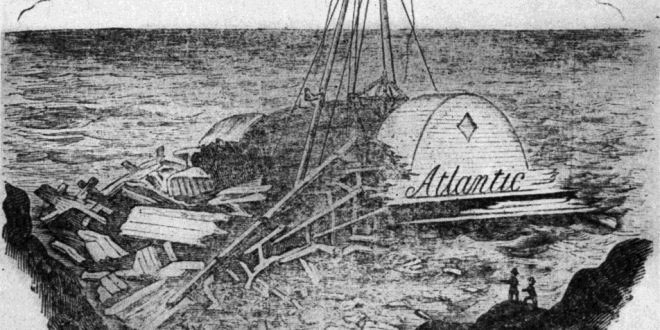The Bell that Got Away
by Pierce Rafferty
November 2012
The passenger steamer Atlantic, bound for New York from Boston, stopped in New London early on the morning of November 26, 1846 in the midst of a furious gale. After proceeding from that port, she suffered a boiler accident several miles from the mouth of the New London harbor. All day Thursday, Thanksgiving Day, she dragged her anchors as the storm slowly pushed her closer to certain doom on Fishers Island’s north shore. At 4:30 a.m. on Friday, November 27th, the last anchor cables snapped and the Atlantic crashed onto the rocks at the base of North Hill.
Approximately 42 passengers perished and 56 survived. Because the passenger log was never completed, the final toll will never be certain. However, one famous object, the ship’s bell, made of granite and weighing some 400+ pounds, survived the wreck and quickly became a central character in accounts, poems and elegies about the tragedy. The bell had fiercely rung during the storm and continued to toll from a broken mast for weeks after the wreck as rescuers and salvage workers did their gruesome work. Over time the bell has, at least in my mind, become Fishers Island’s singular “Elgin Marble,” plucked from our shores, likely never to re-turn, but always wanted. This is the story of how the bell got away.
In January 1847, Rev. Benjamin C.C. Parker, a port chaplain and missionary who worked with seamen in the Port of New York, read Miss Frances Caulkins’ poem about the wreck of the steamer Atlantic that featured the ship’s bell tolling mournfully above the wreckage. Rev. Parker, considerably moved, decided to secure the bell and place it in his organization’s Floating Church of the Holy Comforter, then moored near the southern tip of Manhattan. After following several false leads, he eventually determined that the party with the legal right to sell the bell was the Atlantic Insurance Company, based on Wall Street. He contacted that business concern and located a clerk who was personally familiar with the wreck having spent time on Fishers Island settling the claim. The clerk informed him that: “the work-men engaged in salvaging the wreck had begged him after several days to have the bell taken down, because while engaged in their gruesome task its tones made them so melancholy they could not work. While it was being taken down, the bell fell overboard and with great trouble had been fished up and landed at New London, where the captain of the Cleopatra had laid hands on it and taken it on board, to put up in place of his own bell.” With the bell in danger of disappearing over the horizon on a new ship, Rev. Parker doubled efforts and convinced the insurance company to back his efforts. Faced with a determined two-front retrieval campaign, the captain released the bell to Rev. Parker for its original cost, a figure determined to be $133.98. Having personally borrowed the money, Rev. Parker initiated a campaign to help recoup the purchase price and associated costs. Sympathetic lady patrons responded with a “subscription,” led in their efforts by Mrs. Alexander Hamilton. When that effort fell short, Rev. Parker displayed the bell in a prominent storefront on lower Broadway for a period of five days in early March 1847. At this site it attracted crowds and the necessary funds were raised. In late March 1847, with the accounts all balanced, Rev. Parker and an assembled team of helpers hoisted the bell into the belfry of the Floating Church of the Comforter.
There it remained for the next three decades, calling sailors to worship.
In 1883, the bell was moved ashore to the belfry of the Chapel of the Holy Comforter which became part of the North River Station of the Seamen’s Church Institute. After the North River Station was abandoned in 1923, the bell stood silent in its tower until 1927. At that time it was transferred to the main entrance of the Institute’s building at 25 South Street in lower Manhattan where it “rang the hours by ship’s time.” In 1991, the Seamen’s Church Institute established a new building in the South Street Seaport. There the ship’s bell from the ill-fated steamer Atlantic hangs to this day, affixed in a prominent position on the exterior wall high above the main entrance on Water Street. It is inscribed with details about the wreck, lines of poetry, and an acknowledgment of the lady subscribers.


